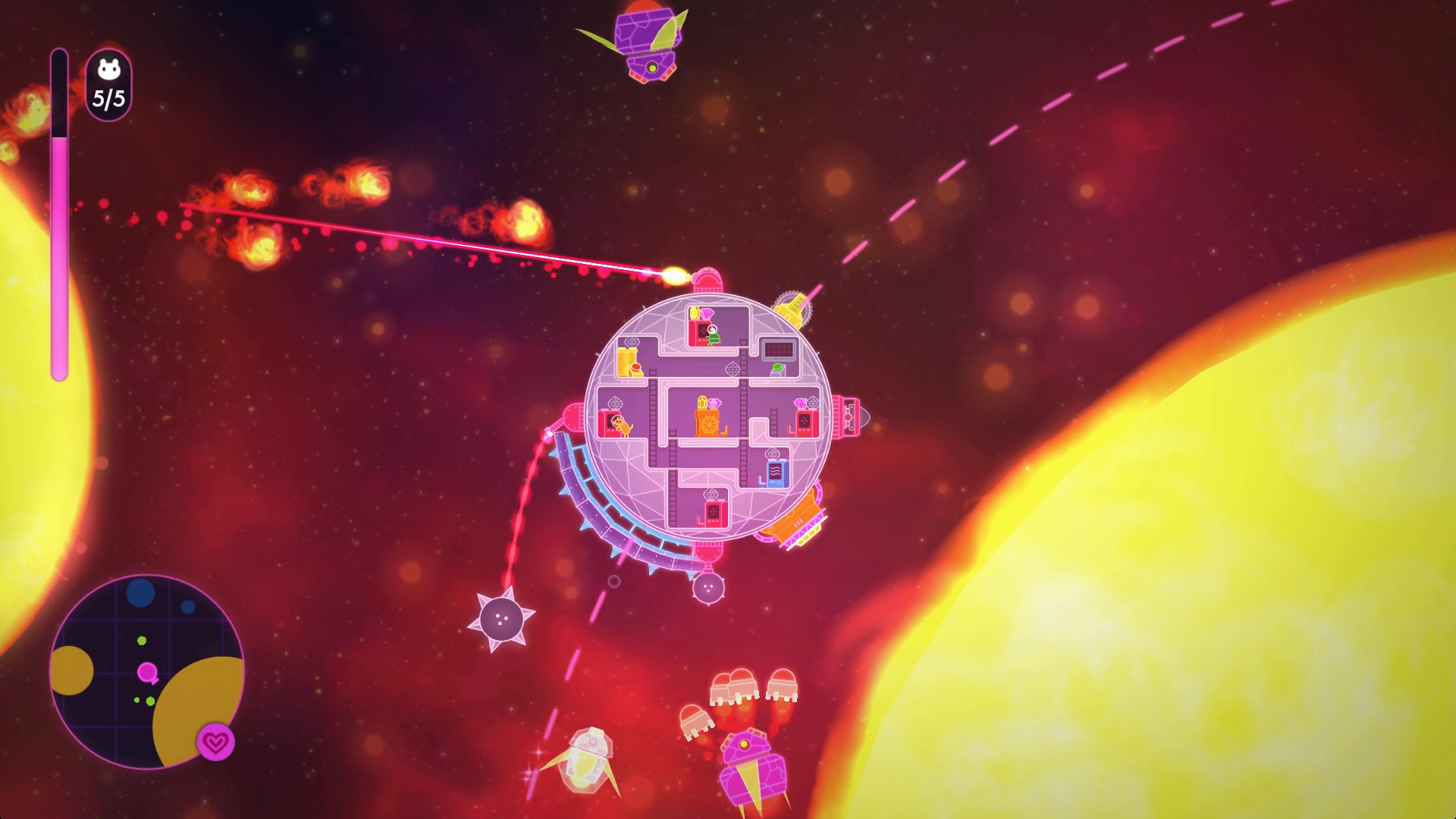

Somewhere between the vastness of Spaceteam and Artemis: Spaceship Bridge Simulator lies Lovers in a Dangerous Spacetime, a game centered around the act of yelling at your friend, flailing, yelling some more, staring at each other in a brief moment of bewilderment, and then bursting out laughing. It’s fun by way of pure, emergent chaos, and escaping from that chaos intact makes you feel like you just swiped the Mona Lisa from MI5. Building a game off this idea is one of the toughest balancing acts a developer can attempt, but Asteroid Base does so with astounding precision.
Lovers’ story offers just enough to get you on your way, boiling down to the fact that you and your co-pilot must navigate the cosmos to rescue your screaming animal pals (bunnies, frogs, etc). Transportation takes the form of a circular spaceship with eight stations: four controlling directional turrets, one controlling a movable shield, one controlling steering, one bringing up a map, and one to activate a sort of super-weapon. Here’s the thing, though: there’s just the two of you, meaning you and either an adorable AI partner or an actual, physical friend must scramble around the ship to man each station as the need arises.
And trust me, the need is near-constant.

Using the AI partner works just fine and may even provide a slightly easier experience than in multiplayer, but doing so ignores the primary reason for the game’s existence. Lovers is built from the ground up for its two player local co-op mode, ensuring that the pandemonium emanates both on-screen and on-couch. As the two of you pilot your ship around Lovers’ randomly generated levels, you’ll encounter a number of threats ranging from spike-spewing aliens to robotic planetary patrols to space… whirlpools. To keep your love-craft (heh) from becoming galactic debris, the two of you are constantly clambering from station to station as you steer, fire off weaponry, or block incoming projectiles.
The erratic nature of the levels means that these threats can and will come from any direction, so what starts as inside voices and measured reactions quickly devolves into banshee wails and panicked button mashing. This is where Lovers excels, in the moments that you and your partner dance, surrounded by aliens, careening into a planet, and low on health, yet somehow, somehow, you pull it off. The chaos seems to always drag you into a state just short of sheer hopelessness, and reflecting on those moments of victory make you wonder how you even survived at all.
Outside of deciding who is responsible for what stations, strategy comes in the form of discoverable gems. You’re encouraged to investigate every nook and cranny of each level in search of these elusive power-ups, which can then be used to upgrade and alter each station. Different types of gems can eventually combine, making experimentation crucial to survival. Even in these moments, when the two of you are deciding where to harness your limited resources, discussions have a sort of breathlessness to them, a sense of ever-present danger that Lovers thrives off of.
If you’re this far into the review, you’ve likely surmised as much already, but this game is tough; much of Lovers’ difficulty stems from its roguelike influences. Most levels require you to rescue five of the ten available “friends” to proceed, but they end only when the players choose. Thus, players are presented with the option to try and free more of their screaming chums (which feed into the game’s meta-upgrade loop) and risk losing everything, or escape with the bare minimum and near-assured safety. Lovers offers this decision with deceptive optimism, constantly goading your duo to explore just a little more, to rescue just one more “friend”, even though all logic and reason indicate that you should be careening your alien butts through the closest wormhole.
Lovers’ visual and sound direction also deserves mention. Ryan Henwood does a fantastic job with the sound design, as both the effects and soundtrack add an important layer of context to the experience without reaching the point of distraction. Similarly, the art style is distinct and presents a stark, pleasing contrast to the sheer mayhem on-screen. Based on gameplay alone, one could argue that Lovers was always going to be distinct in the gaming space, but the overall presentation does much to give it a very unique aesthetic quality.
Lovers in a Dangerous Spacetime excels to the point that my biggest complaint is a lack of content (although, honestly, it’s tough to expect much more at this price point). A few minor, inexplicable framerate issues aside, Asteroid Base knew exactly what they were setting out to do and hit every mark possible. That said, it’s possible that the difficulty won’t appeal to every type of gamer. The price of failure means that, in certain types of relationships, frustration could quickly overpower the sense of fun.
What Lovers lacks in depth, it more than makes up for in action. It’s chaotic, it’s stressful, it’s exhausting, it’s fun. For me, it arrives at the very essence of why I adore co-op games: the shared experience. It’s the chance for two people to dot the memory of their relationship with moments of glory, heartache, and most importantly, joy. Through victory or failure, Lovers in a Dangerous Spacetime provides joy in pure, unfiltered bundles, and I simply can’t find a reason that I wouldn’t recommend including that in your life.